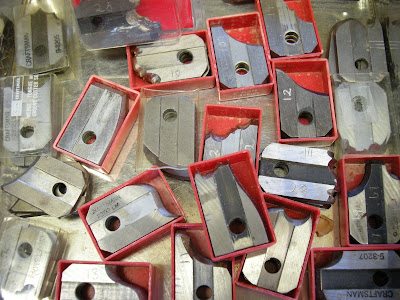
Some Decorative Ideas
Sometimes the frame made from a simple molding appears just a little too plain. I first wrestled with this issue when I was making new frames to display some paintings my grandfather had made some eighty years ago. I had added a linen covered liner frame and that really gave a good effect, but it was still just too quiet. I solved this by using a small rectangular grounding punch, as illustrated in (DSC02524).
A few years back, I bought some more decorative punches from my favourite tool store – ‘Lee Valley Tools’ – based in Ottawa. http://www.leevalley.com/ I put them to good use when I wanted to make a special frame for a two-hundred year old piece of silk embroidery, which had come down through my family. For this, I wanted to evoke the Regency era with some fine detail. I did this by first making a plant ‘stem’ along the molding by alternate shallow cuts with a carving gouge; (DSCN5498). Then I added little oak leaves and acorns with the punches. Feeling that the design was not yet quite full enough, I lastly added a sprinkle of little flowers. I did all this freehand. Don’t fuss with a measured layout. Trust your eye. This may look a little rough when studied close-up in a harsh light, but the final effect on the wall is exactly right. (DSCN5448, 5450).
I stumbled upon another method for making a frame more ornate when I acquired a number of lengths of decorative fillet (DSCN5528) I had been in discussion at the framing shop as to how best to display a rather special watercolour, and it was suggested that I use a double matt separated by a fillet. A selection of designs were brought out and we quickly agreed on a good treatment for the picture. But I then went on to muse out loud as to whether I couldn’t make these tiny moldings myself, and thought how they might be useful to dress up other frame moldings. The upshot was that I was offered a bundle of fillets left over from old projects in order to clear out useless stock. I chose one of these to enhance a molding design I had already used once in its simpler form; (the larger, gold coloured molding in (DSCN5470). Now, instead of running a rabbet on the inner edge, I cut a slot to receive the supporting side of the fillet. The underside of the decorated half of the fillet now provided the land for the picture; (DSCN5340). The finished result is shown in (DSCN5536).
Well now, that’s about it for the time being. In a future blog, I’d like to explain some tips and tricks I have learned for matting watercolours, prints and photos. I did not find the intricacies of this explained in the ‘How to’ books I consulted. I learned the basics from the owner of an Art Supply store, and more recently, some refinements from my Frame Store friend. That topic needs a bit of working up.
If you’ve read to the end here, then you probably intend to try out some of the ideas I have put forward. I hope that this little exposition will help you.
Mind your fingers!
A few years back, I bought some more decorative punches from my favourite tool store – ‘Lee Valley Tools’ – based in Ottawa. http://www.leevalley.com/ I put them to good use when I wanted to make a special frame for a two-hundred year old piece of silk embroidery, which had come down through my family. For this, I wanted to evoke the Regency era with some fine detail. I did this by first making a plant ‘stem’ along the molding by alternate shallow cuts with a carving gouge; (DSCN5498). Then I added little oak leaves and acorns with the punches. Feeling that the design was not yet quite full enough, I lastly added a sprinkle of little flowers. I did all this freehand. Don’t fuss with a measured layout. Trust your eye. This may look a little rough when studied close-up in a harsh light, but the final effect on the wall is exactly right. (DSCN5448, 5450).
I stumbled upon another method for making a frame more ornate when I acquired a number of lengths of decorative fillet (DSCN5528) I had been in discussion at the framing shop as to how best to display a rather special watercolour, and it was suggested that I use a double matt separated by a fillet. A selection of designs were brought out and we quickly agreed on a good treatment for the picture. But I then went on to muse out loud as to whether I couldn’t make these tiny moldings myself, and thought how they might be useful to dress up other frame moldings. The upshot was that I was offered a bundle of fillets left over from old projects in order to clear out useless stock. I chose one of these to enhance a molding design I had already used once in its simpler form; (the larger, gold coloured molding in (DSCN5470). Now, instead of running a rabbet on the inner edge, I cut a slot to receive the supporting side of the fillet. The underside of the decorated half of the fillet now provided the land for the picture; (DSCN5340). The finished result is shown in (DSCN5536).
Well now, that’s about it for the time being. In a future blog, I’d like to explain some tips and tricks I have learned for matting watercolours, prints and photos. I did not find the intricacies of this explained in the ‘How to’ books I consulted. I learned the basics from the owner of an Art Supply store, and more recently, some refinements from my Frame Store friend. That topic needs a bit of working up.
If you’ve read to the end here, then you probably intend to try out some of the ideas I have put forward. I hope that this little exposition will help you.
Mind your fingers!






